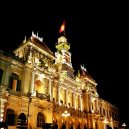Vietnam
Vietnam: Travel tips, articles, photos, gallery, cities database, population, pics, flags, statistics, free maps online
Back to Countries, Click to read the whole article: Vietnam
| Introduction - Vietnam: | | Location - Vietnam: | | People - Vietnam: | | Government - Vietnam: | | Economy - Vietnam: | Economy overview | Vietnam is a densely-populated, developing country that in the last 30 years has had to recover from the ravages of war, the loss of financial support from the old Soviet Bloc, and the rigidities of a centrally-planned economy. Substantial progress was achieved from 1986 to 1997 in moving forward from an extremely low level of development and significantly reducing poverty. Growth averaged around 9% per year from 1993 to 1997. The 1997 Asian financial crisis highlighted the problems in the Vietnamese economy and temporarily allowed opponents of reform to slow progress toward a market-oriented economy. GDP growth averaged 6.8% per year from 1997 to 2004 even against the background of the Asian financial crisis and a global recession, and growth hit 8% in 2005 and 7.8% in 2006. Since 2001, however, Vietnamese authorities have reaffirmed their commitment to economic liberalization and international integration. They have moved to implement the structural reforms needed to modernize the economy and to produce more competitive, export-driven industries. Vietnams membership in the ASEAN Free Trade Area (AFTA) and entry into force of the US-Vietnam Bilateral Trade Agreement in December 2001 have led to even more rapid changes in Vietnams trade and economic regime. Vietnams exports to the US doubled in 2002 and again in 2003. Vietnam joined the WTO in January 2007, following over a decade long negotiation process. This should provide an important boost to the economy and should help to ensure the continuation of liberalizing reforms. Among other benefits, accession allows Vietnam to take advantage of the phase-out of the Agreement on Textiles and Clothing, which eliminated quotas on textiles and clothing for WTO partners on 1 January 2005. Agricultures share of economic output has continued to shrink, from about 25% in 2000 to 20% in 2006. Deep poverty, defined as a percent of the population living under $1 per day, has declined significantly and is now smaller than that of China, India, and the Philippines. Vietnam is working to create jobs to meet the challenge of a labor force that is growing by more than one million people every year. Vietnamese authorities have tightened monetary and fiscal policies to stem high inflation. Hanoi is targeting an economic growth rate of 7.5-8% during the next five years. | | Gdp purchasing power parity | $262.8 billion (2006 est.) | | Gdp official exchange rate | $48.43 billion (2006 est.) | | Gdp real growth rate | 8.2% (2006 est.) | | Gdp per capita ppp | $3,100 (2006 est.) | | Gdp composition by sector | agriculture: 20.1%
industry: 41.8%
services: 38.1% (2006 est.) | | Labor force | 44.58 million (2006 est.) | | Labor force by occupation | agriculture: 56.8%
industry: 37%
services: 6.2% (July 2005) | | Unemployment rate | 2% (2006 est.) | | Population below poverty line | 19.5% (2004 est.) | | Household income or consumption by percentage share | lowest 10%: 3.6%
highest 10%: 29.9% (1998) | | Distribution of family income gini index | 36.1 (1998) | | Inflation rate consumer prices | 7.5% (2006 est.) | | Investment gross fixed | 32.6% of GDP (2006 est.) | | Budget | revenues: $15.42 billion
expenditures: $16.63 billion; including capital expenditures of $1.8 billion (2006 est.) | | Public debt | 47.5% of GDP (2006 est.) | | Agriculture products | paddy rice, coffee, rubber, cotton, tea, pepper, soybeans, cashews, sugar cane, peanuts, bananas; poultry; fish, seafood | | Industries | food processing, garments, shoes, machine-building; mining, coal, steel; cement, chemical fertilizer, glass, tires, oil, paper | | Industrial production growth rate | 11.3% (2006 est.) | | Electricity production | 40.11 billion kWh (2004) | | Electricity consumption | 37.3 billion kWh (2004) | | Electricity exports | 0 kWh (2004) | | Electricity imports | 0 kWh (2004) | | Oil production | 400,000 bbl/day (2005 est.) | | Oil consumption | 230,000 bbl/day (2004 est.) | | Oil exports | NA bbl/day | | Oil imports | NA bbl/day | | Oil proved reserves | 2.5 billion bbl (2006 est.) | | Natural gas production | 6.342 billion cu m (2005 est.) | | Natural gas consumption | 6.342 billion cu m (2005 est.) | | Natural gas exports | 0 cu m (2005 est.) | | Natural gas imports | 0 cu m (2005 est.) | | Natural gas proved reserves | 192.6 billion cu m (1 January 2005 est.) | | Current account balance | $1.029 billion (2006 est.) | | Exports | $39.92 billion f.o.b. (2006 est.) | | Exports commodities | crude oil, marine products, rice, coffee, rubber, tea, garments, shoes | | Exports partners | US 20.7%, Japan 12%, Australia 9.2%, China 5.6%, Germany 4.4% (2006) | | Imports | $39.16 billion f.o.b. (2006 est.) | | Imports commodities | machinery and equipment, petroleum products, fertilizer, steel products, raw cotton, grain, cement, motorcycles | | Imports partners | China 17.2%, Singapore 12.6%, Taiwan 11.2%, Japan 9.5%, South Korea 9.3%, Thailand 7.1%, Malaysia 4% (2006) | | Reserves of foreign exchange and gold | $11.92 billion (2006 est.) | | Debt external | $21.86 billion (2006 est.) | | Economic aid recipient | $2.8 billion in credits and grants pledged by the 2006 Consultative Group meeting in Hanoi (2004) | | Currency code | dong (VND) | | Exchange rates | dong per US dollar - 15,983 (2006), 15,746 (2005), (2004), 15,510 (2003), 15,280 (2002) | |
| Communications - Vietnam: | | Transportation - Vietnam: | | Military - Vietnam: |
This page was last updated on 16 September, 2007
Source: CIA >>> |




